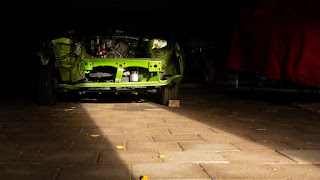Went to the shed for a few hours over the weekend, to check over a few things on the DHC. Main reason for this was to try and work out how to plan and carry out this project, in order to finish the damage quotation for the insurance. On one of my previous visits, I already noticed some paint damage on the top front of rear wings. But now I noticed both doors were standing out a little at the back. And sure enough there’s some damage on both B-posts, caused by the sills bending a little under the force of the impact. Nothing life threatening, but this means that the B-posts also need work doing, because both strikers have slightly deformed the B-post. And that means more dismantling to be done!
I spent the rest of the time in trying to salvage some items of the parts I removed from the car so far. As expected not much joy there. As these parts of one of the headlamp mechanisms clearly shows. Though it looks salvageable, the lifting motor is beyond repair. It’s axle shaft is bent, preventing it from turning.
And as the weather was rather fine there was some lovely light entering through the shed’s gate. And as I always have a camera with me, that was something I couldn’t ignore!



















